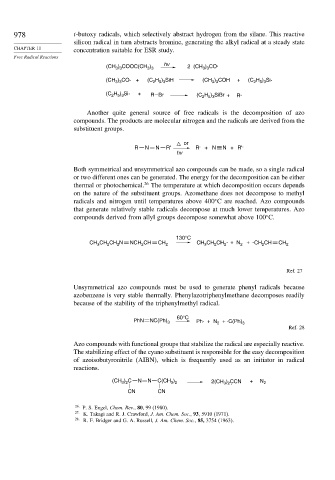Page 994 - Advanced Organic Chemistry Part A - Structure and Mechanisms, 5th ed (2007) - Carey _ Sundberg
P. 994
978 t-butoxy radicals, which selectively abstract hydrogen from the silane. This reactive
silicon radical in turn abstracts bromine, generating the alkyl radical at a steady state
CHAPTER 11 concentration suitable for ESR study.
Free Radical Reactions
) CO·
(CH ) COOC(CH ) hv 2 (CH 3 3
3 3
3 3
) CO· +
(CH 3 3 (C H ) SiH (CH ) COH + (C H ) Si·
2 5 3
3 3
2 5 3
H ) Si· +
(C 2 5 3 RBr (C 2 H 5 ) 3 SiBr + R·
Another quite general source of free radicals is the decomposition of azo
compounds. The products are molecular nitrogen and the radicals are derived from the
substituent groups.
or
R N N R' R . + N N + R' .
hv
Both symmetrical and unsymmetrical azo compounds can be made, so a single radical
or two different ones can be generated. The energy for the decomposition can be either
thermal or photochemical. 26 The temperature at which decomposition occurs depends
on the nature of the substituent groups. Azomethane does not decompose to methyl
radicals and nitrogen until temperatures above 400 C are reached. Azo compounds
that generate relatively stable radicals decompose at much lower temperatures. Azo
compounds derived from allyl groups decompose somewhat above 100 C.
130°C
CH CH CH N NCH CH CH 2 CH CH CH 2 + N 2 + CH CH CH 2
2
2
3
2
3
2
2
Ref. 27
Unsymmetrical azo compounds must be used to generate phenyl radicals because
azobenzene is very stable thermally. Phenylazotriphenylmethane decomposes readily
because of the stability of the triphenylmethyl radical.
60°C
PhN NC(Ph) 3 Ph· + N + ·C(Ph) 3
2
Ref. 28
Azo compounds with functional groups that stabilize the radical are especially reactive.
The stabilizing effect of the cyano substituent is responsible for the easy decomposition
of azoisobutyronitrile (AIBN), which is frequently used as an initiator in radical
reactions.
(CH ) C N N C(CH ) 2(CH 3 2 · + N 2
) CCN
3 2
3 2
CN CN
26
P. S. Engel, Chem. Rev., 80, 99 (1980).
27 K. Takagi and R. J. Crawford, J. Am. Chem. Soc., 93, 5910 (1971).
28
R. F. Bridger and G. A. Russell, J. Am. Chem. Soc., 85, 3754 (1963).

